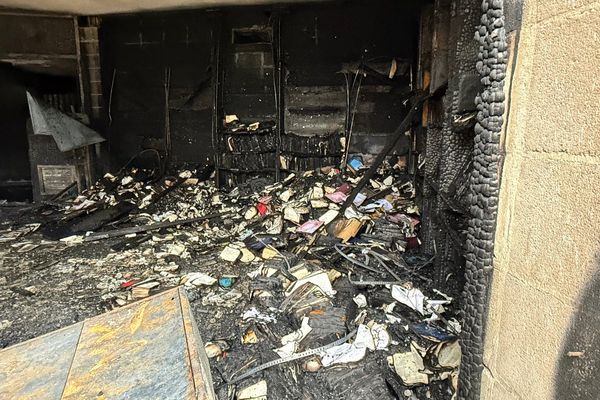
Wildfires have set millions of acres ablaze across Canada so far in 2023. The fires have forced tens of thousands of people to evacuate, destroyed homes and businesses and caused firefighters to work around the clock. AccuWeather forecasters warn that this unprecedented wildfire season has only just begun.
Canada’s wildfire season, which typically runs from May through September, got off to a devastating start very early this year.
Wildfires scorched sweeping swaths of western Canada, including the provinces of Alberta, British Columbia and Saskatchewan last month. A dramatic video from May 3 showed normally blue skies set into an orange blaze in Alberta as towering plumes of wildfire smoke soared higher and higher.
In Alberta, the entire province underwent a month-long provincial state of emergency due to the scope and out-of-control nature of May’s wildfires. The provincial state of emergency expired just last week, according to CTV News.

More recently, historic blazes roared to life in Nova Scotia. One fire in Barrington Lake could be seen clearly on satellite imagery and grew so large that it became the province’s largest on record, according to the CBC.
Currently, some of the worst fires in the nation are raging across large portions of Quebec. More than 100 fires are considered to be out-of-control across the province, according to the CBC.
“This is a scary time for a lot of people from coast to coast,” Prime Minister Justin Trudeau told reporters on Friday.
So far in 2023, Canadian wildfires have been equal parts wide-reaching and devastating. As of May 31, wildfires in Canada had already burned a total amount of more than 1.3 million acres above the 40-year historical average pace for an entire season.
“At its current pace, this year will burn more acres just from mid-May through early June than the entire 2022 wildfire season combined,” AccuWeather Meteorologist Andrew Kienzle said.

As of early June, more than 8 million acres of land have been scorched by wildfires across Canada this year, according to the Canadian Interagency Forest Fire Centre (CIFFC). The CIFFC was tracking more than 400 active fires across the nation on Monday.
Eight million acres is roughly equivalent to 60 percent of the total area of Nova Scotia – more than double the area of the entire state of Connecticut.
Last year, nearly 4.1 million acres were singed by fire across Canada, according to a report from the CIFFC.
“Canada’s worst season in the past 25 years occurred in 2014 when nearly 11.3 million acres were burned,” Kienzle explained. “Remarkably, the 2014 season had yet to record 100,000 burned acres as of early June.”
Only six seasons in the last 40 years have burned more than 10 million acres across the entire wildfire season, Kienzle added.
Huge swaths of western Canada continue to battle drought conditions, which have made the area more vulnerable to wildfire initiation and spread.
In and around the areas closest to Quebec’s ongoing blazes, air quality levels have plummeted. Folks in large portions of Quebec are experiencing air quality levels that range from poor to dangerous.
Worsening air quality levels can make it difficult for anyone to breathe or move around outdoors, especially young children, the elderly or anyone with respiratory concerns.

In addition to the devastating impacts that residents living along the front lines of these wildfires have sustained, wide-reaching smoke will continue to have significant implications on air quality thousands of miles away.
AccuWeather forecasters say a dip in the jet stream will send smoke pouring southward out of Canada and into the northern and eastern U.S. for much of this week.
Smoke will spread over much of the Great Lakes and portions of the interior Northeast while hazy conditions will be even more wide-reaching. This won’t be the first time this season many of the same areas will have to contend with smoke issues.
“The impacts to air quality have been unprecedented this early in the season when we’ve mixed in the wildfire smoke with the dust and other pollutants, including ozone at the ground level, during hot stretches across the Great Lakes and Northeast,” AccuWeather Meteorologist Dean DeVore said.
As the week began, cities like Chicago and Buffalo were already under air quality alerts due to the Canadian smoke.
“It’s remarkable how much impact this smoke has had so early in the season, making days that are actually below historical seasonal averages and comfortable in terms of humidity, look like a hot and humid mid-July or August day,” DeVore added.
Smoke making it to the surface can reduce visibility in addition to air quality, hiding buildings or landscapes that are typically easily seen. Additionally, if atmospheric conditions align, people living in areas where there is more significant smoke might be able to smell the fiery essence.
Smoke in place across levels of the atmosphere above the surface can often contribute to vivid sunrises and sunsets. AccuWeather forecasters explain why this may be the case this week for some across the eastern U.S.
“Smoke is made up of fine particles which do a good job at scattering certain parts of the visible light spectrum,” AccuWeather Meteorologist Matt Benz explained.
The visible light spectrum is the range of wavelengths human beings can see.
“When the skies are filled with fine particles from smoke, the longest wavelengths – the yellows, oranges and reds – appear enhanced as most of the short wavelengths – the purples, blues and greens – get scattered from reaching our eyes,” Benz explained.

When smoke gets closer to the surface, that’s when issues arise.
“But there is a fine line between a blazing sunset and no sunset at all,” Benz added. “Where the smoke is the thickest, the sun may actually disappear from view altogether well before it reaches the horizon.”
Produced in association with AccuWeather







